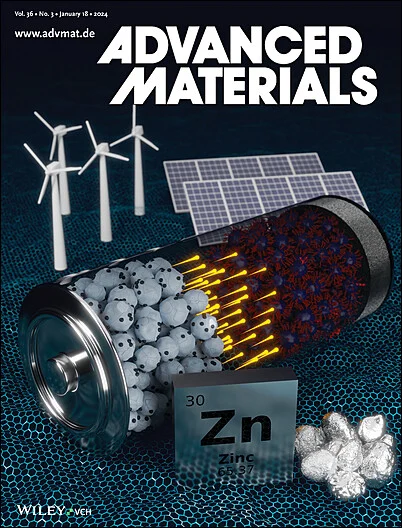Atomically Precise Ruddlesden-Popper Faults Induced Enhanced Emission in Ligand Stabilized Mixed Halide Perovskites.
IF 26.8
1区 材料科学
Q1 CHEMISTRY, MULTIDISCIPLINARY
引用次数: 0
Abstract
Atomic-resolution imaging of Ruddlesden-Popper (RP) interfaces is challenging due to their concealment within perovskite nanocrystals (NCs) and the inherent limitations of conventional characterization techniques. In this study, distinctly oriented RP faults have been detected using double-Cs-corrected high-angle annular dark-field scanning transmission electron microscopy (STEM). A simple yet reliable STEM approach to achieve atomically precise identification of Pb, Cs, Br, and I atoms and analyze their spatial atomic arrangements in a single NC is employed. In addition, dislocations caused by lattice mismatch at grain boundaries (GBs) are identified. Lattice strain in GBs and RPs is determined and quantified, revealing that neither of these planar defects introduces the deep trap levels. Therefore, in absence of Pb dangling bonds or Pb─Pb bonds in GBs and RPs plays a crucial role in stabilizing NCs and preventing ion migration. Incorporating n-octylammonium iodide in pristine CsPbBr3 quantum dots leads to the formation of CsPbBr3- xIx NCs, resulting in a significant redshift in electroluminescence (≈496-623 nm) with enhanced intensity (±79%), attributed to higher exciton lifetime, increased exciton binding energy, and improved carrier confinement in flexible light-emitting devices. Density functional theory calculations confirm that additional carriers localized at the interface enhance electron-hole recombination, ensuring stable charge transportation for lighting devices.配体稳定的混合卤化物钙钛矿中原子精确Ruddlesden-Popper断层诱导的增强发射。
Ruddlesden-Popper (RP)界面的原子分辨率成像具有挑战性,因为它们隐藏在钙钛矿纳米晶体(NCs)中,并且传统表征技术的固有局限性。本研究利用双cs校正高角环形暗场扫描透射电镜(STEM)检测到定向明显的RP断层。采用了一种简单而可靠的STEM方法来实现Pb, Cs, Br和I原子的原子精确鉴定并分析它们在单个NC中的空间原子排列。此外,还发现了由晶界处晶格失配引起的位错。测定和量化了GBs和rp中的晶格应变,揭示了这两种平面缺陷都没有引入深阱能级。因此,在GBs和RPs中缺乏Pb悬空键或Pb─Pb键在稳定NCs和阻止离子迁移中起着至关重要的作用。在原始的CsPbBr3量子点中加入n-辛基碘化铵导致CsPbBr3- xIx NCs的形成,导致电致发光的显著红移(≈496-623 nm),强度增强(±79%),这归因于更高的激子寿命,增加的激子结合能,以及柔性发光器件中载流子约束的改善。密度泛函理论计算证实,在界面处的附加载流子增强了电子-空穴复合,确保了照明器件的稳定电荷传输。
本文章由计算机程序翻译,如有差异,请以英文原文为准。
求助全文
约1分钟内获得全文
求助全文
来源期刊

Advanced Materials
工程技术-材料科学:综合
CiteScore
43.00
自引率
4.10%
发文量
2182
审稿时长
2 months
期刊介绍:
Advanced Materials, one of the world's most prestigious journals and the foundation of the Advanced portfolio, is the home of choice for best-in-class materials science for more than 30 years. Following this fast-growing and interdisciplinary field, we are considering and publishing the most important discoveries on any and all materials from materials scientists, chemists, physicists, engineers as well as health and life scientists and bringing you the latest results and trends in modern materials-related research every week.
 求助内容:
求助内容: 应助结果提醒方式:
应助结果提醒方式:


